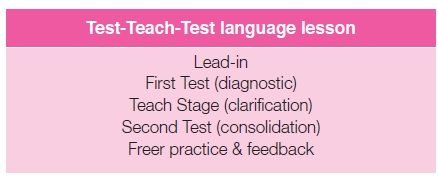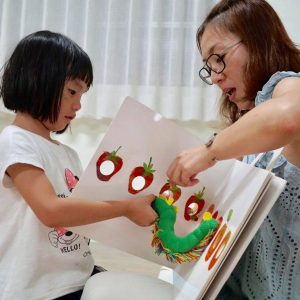Functions 教學:A Test-Teach-Test Lesson
文 / 劉淑嫻 Suzanne Liu
國際教師資格
美語補習班年度最佳講師
師訓講師
上期分享了 Vocabulary 的拼字教學 (以 Text-based 課程為大綱),今天我們來談談 functions 教學,這次要運用的則是 Test-Teach-Test 教學模式。Test-Teach-Test 教學(以下簡稱 T-T-T)是需要兩篇文本的一種教學方法。兩個文本的意義不同,第一篇文本用於讓老師了解學生掌握了什麼,而第二篇則是用於鞏固已學知識並釐清誤區,因此非常適合複習已經教過的內容,然後再次以該教法讓學生更清楚認知語言內容,包括 functions, vocabulary, grammar 等。本次的教案中我會結合一些教具,以 T-T-T 為主軸來設計教學。
這次的教學內容是 functions,很多人會疑惑教語言為何需要教 functions?到底 functions 是什麼?在回答之前,我首先問大家兩個問題:一個單字 ∕ 句子 ∕ 片語,在不同場合表達出來,是否都是一樣的意思?我們如何分辨他們的不同呢?例如下面的圖片,同一句話,意義卻不一。

我們為何要教 functions?因為能讓彼此之間更容易溝通,能夠用多種方式表達自我,以及理解語言表達出的各種感情。我覺得之所以必須在教學中加入 functions,是讓學生更清楚表達的內容和聲調不同,會影響你的語意和目的。而到底什麼是 functions 呢?很多翻譯都無法表達出其意義,所以我用英文解釋,讓大家的理解能更精確。其中包括:asking permission, requesting, offering, giving advice, checking ability, threatening, giving opinion, inviting, apologizing, making a suggestion 等都是 functions。所以簡單來說,就是這句話背後的用意是什麼,為何要講這句話。前面我們提到的 “I’m sorry.” 這句話,如果是為了做錯了事而道歉,會是圖三;如果是要求別人道歉,會是圖一。所以用意不同,表達方式就會不同。
下面我們直接進入 functions 練習課吧!

Stage 1 : Lead in 情境設計
內容:簡短遊戲,引出話題
目的:引起興趣,進入話題 ∕ 情境,了解學生基礎概念
在 lead-in 的環節裡不一定需要大量的教具,同一教具變化玩法也可以實現。這次我用的是木質字母拼字組。這款木質字母有大小寫兩種不同組合。除了經典拼字遊戲,練習字母大小寫對照外,還能用來玩猜單字遊戲。
對方看不到拼好的單字,卻可以知道有多少個英文字母,就能從字數來猜單字。教 functions 時也可以巧妙地使用木質拼字組:老師用詢問的語氣問 “What time is it?”,接著展示一張圖片,讓孩子們用木質字母拼出答案,並用不同的語音語調表達出來。學生拼出 “Five/five”,然後用回答問題的語氣說 “Five/five”。老師用生氣的語氣問 “What time is it?” 學生則用內疚的語氣說 “Five/five”(學生遲到的情境);老師用高興的語氣問 “What time is it?”,學生用興奮的語氣說 “Five/five” (學生期待下課的情境)。
同樣的回答內容,但是意義和情緒都不同。
Stage 2 : First Test 第一次文本
內容:設定閱讀 ∕ 聽力的簡單任務
- 學生進行閱讀 ∕ 聽力活動(聽力練習結束後可以發下聽力逐字稿)
- 兩人一組確認答案
- 學生給予反饋
目的:了解學生對 functions 單字或句型的認知
第二步驟是讓學生選擇具備相同 functions 的字彙或句子,藉此來了解學生對 functions 的理解程度。我們以閱讀為例,先用 5-10 分鐘引導學生快速閱讀以理解內容,並且透過二選一的方式,決定哪個 function 更適合當下的文本環境。以「Giving advice」為例,請學生找出文本中哪些是給予建議的句子。根據句型提問,透過簡單的任務,就可以帶入 You should, You can, You shouldn’t 等句型結構。最後請學生列出經常使用這類句型的生活場景為何。
Alexi: Doctor, I am not sure I understand all the instructions.
Doctor: OK, le’s go over them again. It is very important that you understand.
Alexi: Yes, I know. I just forget easily.
Doctor: That’s OK. You can read all about it here on the back of the medicine. It says, “Take three pills two times a day with water.”
Alexi: Water?
Doctor: Water is best, but you can take it with juice if you like.
Alexi: Thanks. Is it OK to drive?
Doctor: No, you shouldn’t drive. It says that here, under “Precautions.” Oh, and take aspirin every day, too.
Alexi: OK. I will take the aspirin and the other medicine as you have directed me. Thank you!
Stage 3 : Teach stage 教學分析
內容:
- 引出關鍵句 (marker sentence)
- 分析語音語調
- 找出句型公式
- 比較分析
目的:分析關鍵句型的重讀、聲調,還有其他語音的關鍵點。
這個步驟是釐清學生理解程度的關鍵,我會引出關鍵句「You shouldn’t drive.」從而找出句型結構是「S + __________ do something.」讓學生填空並完成相對應的練習,之後問出 CCQs:
1. Is this polite? (No.)
2. Can we say this to our boss? (No.)
3. Can we say this to a friend? (Yes.)
確定理解無誤後,我會讓學生自己比較哪種表達更委婉。如:

Stage 4 : Second Test 第二次文本
內容:
- 閱讀不同文本
- 以 gap-fill 或 multiple choices 等練習強化學生的理解與應用
目的:強化理解和記憶,正確理解句型用意和用法
Noelia: Argh, this is just ridiculous!
Paul: Susan again?
Noelia: Yeah, Susan. She just keeps emailing me about things that have nothing to do with work and nothing todo with me. What do you think I (1)________ do?
Paul: Well, if I were you, I (2)______ email and ask her to stop sending them.
Noelia: I’m not sure that’s a good idea. I have to be careful what I say as she’s quite an important client.
Paul: Erm, I’m not sure then. Perhaps you (3)______ try talking to Yuna about it?
Bob: Er… why don’t you try doing nothing?
Noelia: Sorry?
Bob: Perhaps you (4)_______ just… do nothing?
Noelia: Really? I’m not too sure about that.
Bob: Well, I remember this guy I used to work with, Mark, and he kept emailing again and again, about all sorts, mostly unrelated to work. Well, I kept responding politely and he kept sending them. In the end, I stopped replying to his emails unless they were only about work.
Paul: And what happened?
Bob: He stopped sending them. It’s a bit like being faced with a dangerous snake. If you move quickly, it’ll bite you, but if you keep very still and do nothing, eventually it’ll move away and leave you alone.
結合第二份文本,整個流程讓學生有再次思考和選擇的空間,並作出判斷。讓學生在填寫完後做一些練習,例如選出哪種用法更有禮貌?由學生進行小組討論,有分歧的地方可以全班討論,再由老師分析和說明。
• What do you think I should do?
• If I were you, I’d ask her.
• I’m not sure that’s a good idea.
• Perhaps you could try talking to Yuna.
• Why don’t you try doing nothing?
• I’m not too sure about that.
接下來的小遊戲是運用突發狀況紙條做隨機問答互動。全班一人拿一張紙條,然後老師播放音樂,所有人在教室裡走動直到音樂停止,學生 A 要向離自己最近的學生 B 尋求建議。例如「I have left my phone on the bus.」B 就可以運用「You’d better…」來造句,給出真正的建議。音樂再次響起,再去問一個新朋友的建議。最後讓大家選出自己心目中的最佳建議和最差建議。
Stage 5 : Free Practice 分享性練習
內容:更自由的練習模式,進行以學生為中心的活動
目的:讓學生有更多機會能夠運用所學的語言,增加使用的可能性和頻率
最後可以讓學生自己思考並提出問題,讓其他人給出建議。可以給他們提示和引導,先從日常情境開始,例如自己生病的時候,尋求朋友 ∕ 醫生的建議,或是購買新手機的時候,尋求父母∕朋友的建議,從而創造屬於自己的一段對話,如此未來在生活中也能運用自如了。








